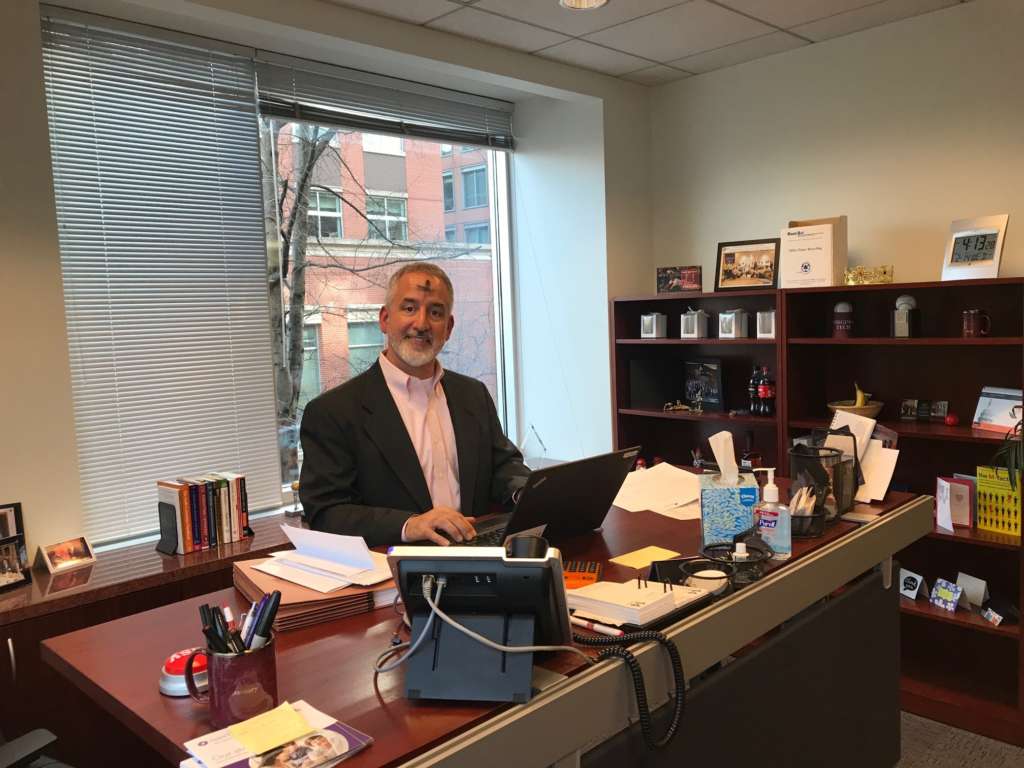

Carlos Otal, the managing partner for Grant Thornton’s public sector, discusses in Federal News Radio’s new show, Views from the Corner Office, that there is...
Views from the Corner Office is a new show designed to talk to the private sector leaders that influence and impact the federal market. The goal of this monthly discussion is for federal executives, lawmakers and other industry experts to gain insights and a better understanding into the trends, the challenges and the evaluation of the technology, acquisition and leadership in the federal market by the executives who lead the federal practices of government contractors.

Carlos Otal, the managing partner for Grant Thornton’s public sector, sat down with Federal News Radio’s executive editor Jason Miller at his office in Alexandra, Virginia.
Best listening experience is on Chrome, Firefox or Safari. Subscribe to Views from the Corner Office’s audio interviews on Apple Podcasts or PodcastOne.
Here are some excerpts from that discussion.
JM: Is it a good time to be a federal contractor?
CO: Right now it’s a very chaotic time. It’s the same, I think, whether you’re a federal contractor, a federal employee, and there’s a lot of uncertainty, a lot of chaos, and we have to all roll with the punches. Does it inhibit our ability to do the business of government, to serve the constituents? That’s where we all need to focus our attention. But what I do think is that this is the new normal. This is something we’ve been seeing. You go back to the 2013 shutdown and it’s not going to be the same. I don’t see us going back to the days of yore and sort of a steady state and a lot of agreement on what’s going on, I think this is going to be the new norm and we all have to adapt to that while we have a budget deal, you know, in principle there still has to be appropriations and we just don’t know what’s going to happen.
JM: This is a new normal that’s maybe worse on the scale of normality. Talk a little bit about how that affects you in the federal marketplace from this uncertainty, this chaos, but more generally the ongoing continuing resolutions. We hear a lot of how it effects federal agencies, but what about the contractor world?
CO: It requires a greater degree of flexibility and agility. We’re always constantly monitoring what’s going on, the funding of appropriations, things that flow down particularly to our contracts, but to our clients and how our clients are being impacted and looking at that. We have to be able to scale up and scale down and make sure our people are productive. So we have a whole set of protocols just as an agency does for when they’re preparing for a shutdown and then it happens, and then what happens when it ramps back up and the lights get turned back on. We have similar plans and protocols in place to make sure that our people are as productive as possible during these periods of times and we’re always prepared to execute sort of like a firehouse, if you will.
JM: Walk me through that a little because I think that’s fascinating. How do you guys prepare for a shutdown?
CO: When we talk about people being productive training is a big part of that. So as a public accounting firm, we have requirements that our people have a certain amount of continuing professional education credits. And so one of the things we do is we’re prepared that if there is a shutdown, people come in the office, we have training set up for them usually for two days because as you know, at a minimum, because even if the government turned the lights back on, it doesn’t happen overnight.
JM: What are some of the trends that you are seeing in the federal marketplace as Grant Thornton is a consulting services and financial management firm.
CO: I think the real sea change that I’m seeing in agencies is their interest in wanting to be innovative and understanding what’s out there so that they can be innovative and whether it’s block chain, whether it’s robotics, advanced analytics, they now want to be more on the leading edge. This is a big change from the past where I think government didn’t want to be the guinea pigs. They wanted the products and the solutions to be mature and proven. Now that we’ve had to do not just more with less but less with less, they’re more apt to try innovation, to pilot solutions, and we’re helping agencies strategize about how to do that best and to help implement and start some of the pilots in these areas.
I think the increased use of analytics is another trend we’re seeing. And that’s across the board. While there’s always been discussion about big data, we’re firm believers that that isn’t where you start. There’s a lot of data already there. How do we help agencies make better decisions even with the data they have and help inform them of other data sets that they can use. How can they, how do they need to clean up their data to mature along the spectrum of analytics so that they can become more curious and really use it for decision making.
That really leads into the area of evidence-based and how do you prove out that the investments you’re making are actually working and we see what’s going on with evidence-based policy making. I think there’s some pending legislation that’s going to come and that’s going to take data. How do we inform our constituents, the Hill, the taxpayer and others that these programs are working as designed, or which programs should we put more dollars toward? And we need evidence to do that. We should be playing not like big level, but you know, when you think about the moneyball for government concept, we should be playing moneyball for government in that area and doing a lot more of it.
JM: You said a real sea change is happening. Agencies want to be on the front end instead of, if you will, on the backend where the technology is more mature. Give me a sense of whether the words match the actions?
CO: Procurement needs to catch up with the thinking of what the end customers are looking for if they want innovation, and we have to find innovative ways to do those procurements. I think that they already have those procurement authorities, they just don’t tend to use them. They tend to default to the things they know. Several years ago, the Office of Management and Budget put out the Mythbusters. I think people should dust off the Mythbusters for federal procurement policy. There are lots of things in there and a lot of tools that don’t get used right. There can be more conversations with industry, more dialogue and sort of show me before you even buy, and there’s a lot of ways that you can do that.
Government tends to want to not talk or think they can’t talk because they might procure something and we need to come back to that. There is the ability to buy commercially and when that’s the right approach to really take a commercial approach to it and not be constrained by the other parts of the procurement regulations because you’re trying to be innovative. You’ve got to look at how you might procure things commercially because not all of our alliance partners and solutions that we’re bringing have worked with the government before. They’re used to working in the commercial arena and it’s a very difficult thing for them to adapt that way and I think that’s why you hear that from some of the vendor community that you’re talking to.
JM: What’s your take on requests for information? What’s your take on industry days? Are they valuable? Should the government just figure out a different approach?
CO: I think RFIs are pointless. There are marketing exercises. You can say anything in an RFI really. I think most of the time the government still doesn’t understand what they’re really looking for and I think it just serves to confuse what they need to buy. And then they still put out a procurement that the vendors are scratching their heads and it looks like Wordperfect 5.1. Right? That’s the point. I haven’t seen the RFI process used successfully.
Industry days tend to be the same way there. They tend to be one-way dialogues and don’t provide that same outlet for somebody to give insights because you feel like you’re sitting there with your competitors and you’re just not going to say things that you might say in other forums.
I don’t think government gets value out of those things and I think they need to find the forums that would really give them the values and insights and the tools to do that and to actually bring those innovations to their procurements.
JM: Talk a little bit about what you see around mergers and acquisitions. What does that say to you about the federal sector?
CO: I think it says the sector is healthy. People are looking about how can they optimize their businesses to better serve government. I think we’ll see more of that particularly in the defense and aerospace areas. Like everybody else, we’re active in this market. We’re always looking. There’s always discussion. I think people frankly would be surprised at how much activity there is and the things that just don’t get done either. What it means to me and how we look at it is it really keeps us fresh and focused on our business. We always have to think about the future and so we’re always thinking about doing an acquisition, merging, joint ventures or do we do a carve out or something that maybe we don’t want to be doing any longer.
The activity is really good because it keeps me on my toes and thinking about my business and what’s the best thing, Grant Thornton and what we should be doing and what we can be doing.
Copyright © 2025 Federal News Network. All rights reserved. This website is not intended for users located within the European Economic Area.
Jason Miller is executive editor of Federal News Network and directs news coverage on the people, policy and programs of the federal government.
Follow @jmillerWFED


